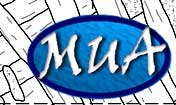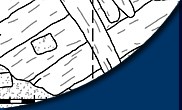
Project Journal Wrap Up Page 2 of 2
26 August 2008
By Wayne Abrahamson, Kendra Kennedy,
Dean Nones, Greg Cook,and Tiffany Goldhamer
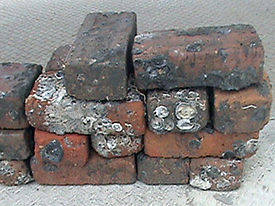
Example of the types of bricks found on the Brick Wreck.
Brick Wreck by Dean Nones
Each student in the maritime field school had a chance to work on the Brick Wreck and experience what it's like to work in a low to zero visibility environment. Students were involved in dredging, recording, probing the site extents, and collecting wood samples. A baseline was set up on the site running from the southern most extent to the northern most extent of the site. Excavation was completed on a third 1m x 1m test unit, exposing the hull of the ship which the students then recorded. Students then set up a fourth 1m x 1m test unit on the brick pile, and proceeded to excavate the unit. What was found here was a large quantity of brick that appear to still be stacked in a pallet-like formation. This would seem to indicate that the ship was not salvaged when it sank.

Dean Nones, Field Director in Training for the Brick Wreck.
A sample of brick was collected from the brick pile. These brick were measured and were munselled in order to determine the color of the clay from which they were made. Students also attempted to find a name on one of the bricks. This would help tie the site in with one of the local brick yards operating in the 19th century. The portion of the site on the west side of the baseline was probed to determine the extent of the site. This would also help in determining the outline of ship's hull. Finally, wood samples were taken from the hatch, outer hull, inner hull, "secondary inner hull", and a frame. These wood samples will help determine where this ship was made. I would like to thank all of students that assisted me this summer, all of you did a great job.
Emanuel Point II by Greg Cook
UWF students and staff excavated ten one-by-one meter units on the Emanuel Point II site this summer, focusing primarily on the north (tentatively identified as the bow) and south areas of the site to determine hull integrity and site extents.
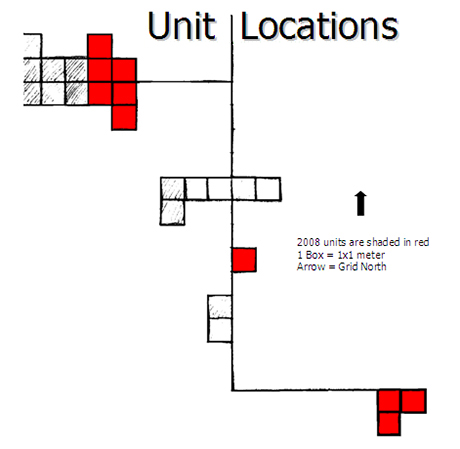
This rough map shows the location of the 2008 summer units (Red) in relationship with older units opened during previous field seasons.
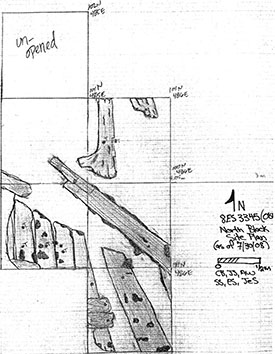
Site plan of the northern units created by the students.
In the northern units, divers uncovered portions of the keel and outer hull planking, mapping in hull strakes as they converged toward the presumed bow of the vessel. Evidence suggests that the north end of the site is partially disintegrated, and it is probable that portions of the upper bow/forecastle broke off toward the west of the site, which was uncovered in summer of 2007. Though the keel was slightly eroded, divers noted the scarf that likely joined the keel to the stem of the vessel, though no evidence of the stem has been uncovered so far.
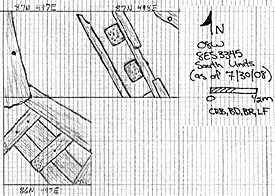
Site plan of the southern units created by the students.
In the southern units, field school students excavated over a meter in depth to uncover extensive ballast and preserved hull timbers that probably represent the stern of the vessel. These include several frames and a portion of the keelson, which appears slightly dislodged due to the wrecking event. As in the bow, though timbers are well preserved, there is evidence of violent impact in the stern that likely resulted from the 1559 hurricane event.

Examples of the type and size of ballast removed from the Central Unit.
Toward the end of field school, archaeologists opened up a single one-by-one unit in the center of the site in an attempt to locate the mast step area of the vessel. Excavators removed an extensive amount of ballast, and came upon preserved textile material which is probably sail cloth. This unit will continue to be investigated during dive operations on the site in fall of 2008.
Emanuel Point II Artifacts by Tiffany Goldhamer
Artifacts recovered from EPII this summer included a large selection of ceramics, resin, bone, wood, and plant material. One of the most common ceramics found this summer was olive jar. Olive jars were used to hold all types of food and liquids. Jars that held water or wine were coated with pine pitch or resin on the inside. Other ceramics included majolica, green bacin, and other lead glazed coarse earthenwares. Bone collected from the site was from an array of animals including large mammals, birds, fish and turtles. Most of the wood collected is probably dunnage also known as 16th century packing peanuts. Some pieces may be portions of barrels. The plant materials included many seeds, nut hulls, and olive pits. In addition to these artifacts and ecofacts, there were several very exciting and diagnostic finds on EPII this summer. A few of these finds include a wooden bead, possible amber or carnelian bead, and a possible coin.
Please feel free to contact us if you have any questions or concerns at: mua@keimaps.com.
Return to Project Journal home page.
